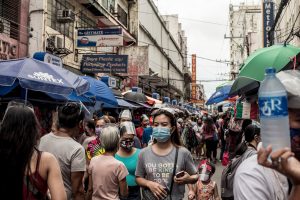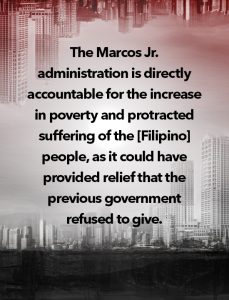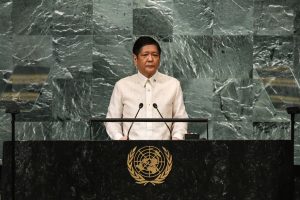|
Getting your Trinity Audio player ready...
|
“A lie which is half a truth is ever the blackest of lies,” said Lord Alfred Tennyson, the British empire’s great poetic defender of colonialism and its plunder.
There’s half a truth in the Marcos Jr administration economic team’s recent bragging that the Philippines “pulled off [its] best full-year performance in 46 years” and is “brimming with economic energy.” Reported economic growth was indeed relatively fast.
The dark lie, however, is the impression the government wants to give that the situation of ordinary Filipinos is improving. The real and whole truth is that it isn’t and, if anything, has even gotten worse in the first few months of the new government.
One world
The claim of the “best” economic performance in decades is from the gross domestic product (GDP) growing by 7.6% in 2022, as reported by the Philippine Statistics Authority (PSA). There’s no reason to doubt the high number which is, at the end of the day, just a statistic about economic output. What is dubious though is the pretense that it’s due to some kind of skillful economic management.
First of all, it’s just a rebound from the long overdue reopening of the economy from the irrationally long and harsh lockdowns of the Duterte government. The main reason growth was so high is because it’s measured from a place that’s so low – the unprecedented 9.5% contraction in 2020 which continued until the early part of 2021. Growth will be much slower this year because that base effect is gone.
Secondly, all that hyped growth has done is bring the level of economic output back to where it was before the pandemic. On a seasonally adjusted basis, according to the PSA, all that was really achieved by the third quarter of 2022 was to return economic output to its level at the end of 2019 or before the lockdowns.
The GDP figures are a half-truth for the economic managers to use for their propaganda and populist sunshine. Still, there are a few people who are certainly much happier with the reopening than others. They are in the part of the Philippine economy that might as well be in another world.
Corporate profits recovered quickly. The net income of the largest 1,000 corporations in the country surged from Php889 billion in 2020 to Php1.8 trillion in 2021 (or US$ 16 billion to US$ 32.5 billion) – a huge 122% increase, according to BusinessWorld data.
The cliché that the rich got richer is very true. The net worth of the 10 richest Filipinos increased further by 5.9% from Php2.26 trillion in 2021 to Php2.39 trillion in 2022 (or US$ 40.8 billion to US$ 43.1 trillion), according to Forbes data converted to pesos at prevailing exchange rates.
Click the right arrow to view the infographic.
Sources: Al Jazeera, Bloomberg, Philstar.net, INQUIRER, Time Magazine
Real world
In the real world of tens of millions of poor and low-income Filipinos, the struggle against high and rising prices is real and was lost. Inflation was continuously rising through most of 2022 and started 2023 with a new 14-year high of 8.7% in January.
Prices of basic goods and services rose particularly fast in the second semester of 2022. The worst burden came from rapidly rising food prices – especially because of how food accounts for the single largest part of family spending. This is in the purview of the agriculture department that the president helms but which only made empty promises of action.
The Marcos Jr administration has also been grossly negligent on the income front. Despite high prices and hype about the economy reopening, the minimum wage hasn’t been increased. For instance, in the National Capital Region (NCR) where the minimum wage is already the highest nationwide, IBON computes that the Php570 (US$ 10.30) minimum wage has lost over Php29 (US$ 0.52) or 5.1% of its purchasing power between July 2022 and January 2023.
SWS reported that the number of families rating themselves as poor or borderline poor increased between June and December 2022– the number of poor families rose by 700,000 to 12.9 million (51% of total families) while the number of borderline poor stayed high at 7.8 million (31%). This combined 20.7 million families (82%) is consistent with IBON estimates on Bangko Sentral ng Pilipinas (BSP) data that some 18.6 million or 70% of households did not have any savings as of the fourth quarter of 2022, colloquially isang kahig isang tuka (living from hand to mouth).

This means that some 19 million to 20 million or 70-80% of Filipino families are poor and vulnerable six months into the Marcos Jr administration –not having any savings to deal with rising prices or any family emergencies.
How does this square with government claims of the “lowest unemployment rate since 2005” which was at 4.2% in November and 4.3% in December, according to the latest data from the PSA? The problem, again, is that the official unemployment rate isn’t the whole story.
Unfortunately, the nature of employment in the country’s semi-feudal economy today is such that “employment” has become an even poorer indicator of whether or not a family is earning enough for the goods and services that it needs.
Some 49 million were reported as employed as of December 2022. However, a huge 21.2 million or over 43% of these were merely self-employed or in other informal work including 13.6 million self-employed, 5.5 million in family farms or businesses, and 2.1 million household help.
And it’s not as if government statistics fully reflect all jobless Filipinos. Because of a change in the unemployment methodology, IBON has previously estimated that as much as 2.5 million to 3 million jobless Filipinos are dropped from the official unemployment figures and disregarded for being “not in the labor force”. It is then possible that the real number of jobless Filipinos entering 2023 can be as much as 9.5 million or even more.
If the economy is seen from the perspective of the majority, as it should be, there are no signs that it is “brimming with energy,” as the economic managers so blissfully put it.
The Philippines also isn’t doing well even among its neighbors in the Association of Southeast Asian Nations (ASEAN). The country actually has the third worst poverty incidence (according to the Asian Development Bank), fourth worst human development index (or HDI, according to the United Nations Development Program), and fourth worst GDP per capita (according to the World Bank).
Choices
The Marcos Jr administration is directly accountable for the increase in poverty and protracted suffering of the people, as it could have provided relief that the previous government refused to give.
 Instead, its economic team declared that “ayuda [aid] is a waste of money” and immediately withheld Php18.9 billion (US$ 341.49 million) in promised targeted cash transfers. The program was supposed to give Php3,000 (US$ 54.21) in ayuda to 12.4 million households or the poorest half of Filipino families. However, according to data from the social welfare department, it only gave Php2,000 (US $36.14) to 9.2 million families.
Instead, its economic team declared that “ayuda [aid] is a waste of money” and immediately withheld Php18.9 billion (US$ 341.49 million) in promised targeted cash transfers. The program was supposed to give Php3,000 (US$ 54.21) in ayuda to 12.4 million households or the poorest half of Filipino families. However, according to data from the social welfare department, it only gave Php2,000 (US $36.14) to 9.2 million families.
It isn’t doing any better this year. The budgets for regular emergency assistance (including for distressed families, informal workers, and overseas workers) and for the government’s flagship social assistance program called Pantawid Pamilyang Pilipino Program are cut by Php7.5 billion (US$ 135.5 million) and Php5.1 billion (US$ 92.1 million), respectively, in 2023. Even the budgets for community development and micro, small, and medium enterprises are cut by at least Php5 billion (US$ 90.3 million).
The Marcos Jr administration’s distorted priorities are clear. It chooses to bloat budgets for infrastructure (rising to Php1.2 trillion or US$ 21.68 billion) for the benefit of pork barrel-hungry politicians, domestic real estate oligarchs, and the export enclave operations of foreign monopoly capital. There is also dutiful debt service to foreign and domestic creditors who can afford to give debt relief (Php1.6 trillion or US$ 28.9 billion for interest and amortization).
There are also brazenly self-serving allotments – the offices of the president and vice-president get an unprecedented Php11.3 billion (US$ 204.1 million), and the budget for shadowy pseudo-audited confidential and intelligence spending amounts to Php9.3 billion (US$ 168 million).
Plans
Pres. Ferdinand “Bongbong” Marcos Jr. took office 36 years after his father, the dictator Marcos, was ousted by a people’s uprising for his immense political and economic sins. The father’s world-class corruption and human rights violations combined with the neoliberal opening up of the economy according to International Monetary Fund – World Bank prescriptions to cause the worst economic collapse in the country’s post-war history, and caused widespread suffering among the people.

Today, corruption remains endemic and gross human rights violations continue even without the outward form of dictatorship and especially against those struggling for real and radical socioeconomic reforms.
The current government relentlessly insists on obsolete free market policies. It zealously protects over 40 years of globalization policies and is pushing even more trade and investment liberalization, privatization, and deregulation, as can be gleaned from the Philippine Development Plan 2023-2028, released at the end of last year.
The government just ratified the Regional Comprehensive Economic Partnership, yet another free trade agreement on top of the nine (9) already in place aside from those under the World Trade Organization. It is also using its supermajority in Congress to take away the last remaining economic protections for the national economy from the 1987 Constitution.
It already revised the implementing rules of the Build-Operate-Transfer law to expedite the privatization of critical infrastructure. The scope of coverage was expanded and fulfilling requirements made easier. The government’s regulatory authority was weakened and provisions were added for direct government subsidies to private profits.
The political and economic sins of the Marcos dictatorship continue under the Marcos Jr administration, and the people’s movement for real and radical change remains as urgent as ever.◉
A longer version of this was originally published by IBON Foundation, a non-stock, non-profit development organization based in the Philippines. Reprinted with permission.

























